Chapter 5
Equipment for Conscious Sedation
Aim
The aim of this chapter is to describe the equipment required for the administration of conscious sedation and other essential items such as patient monitoring devices.
Outcome
After reading this chapter you should be familiar with the equipment used during conscious sedation in primary dental care.
Inhalational Sedation
All modern inhalational Relative Analgesia (RA) machines are derived from simple anaesthetic machines. They are modified to ensure a minimum concentration of 30% oxygen at all times, which makes them safe for use by a sedationist who is concurrently carrying out the dental treatment. A variety of different commercial models are available. All have similar operational principles and safety features (Figs 5-1 and 5-2).
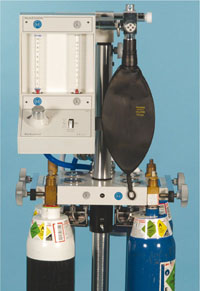
Fig 5-1 McKesson RA machine.
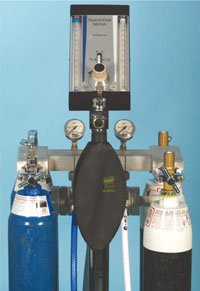
Fig 5-2 Matrx MDM RA machine.
Gas supply
The gas supply to Relative Analgesia machines may be provided by cylinders mounted below the Relative Analgesia head on a mobile support. In surgeries where several Relative Analgesia units are installed, a pipeline system which supplies gas from a remote tank or large cylinder storage area may be more practical.
Nitrous oxide (N2O) is supplied in a blue cylinder containing both a gas and liquid phase at a pressure of 5400 kPa (800 psi). Oxygen (O2) comes as compressed gas in a black cylinder with a white shoulder at a pressure of 15,000 kPa (2000 psi).
Most free-standing inhalational sedation machines are designed to operate with two nitrous oxide and two oxygen cylinders. One cylinder of each gas is designated “IN USE” whilst the other is held in reserve and designated “FULL”. During administration of Relative Analgesia only the “IN USE” cylinder for each gas should be turned on.
The Pin Index System is a safety feature designed to ensure that gas cylinders are correctly mounted on mobile Relative Analgesia machines. This system prevents the accidental interchange of nitrous oxide and oxygen cylinders. Each gas cylinder has two holes drilled into the valve block which exactly match pins on the machine’s manifold or yoke (Fig 5-3). The pattern of holes and corresponding pins is unique for each gas (Figs 5-4 and 5-5).
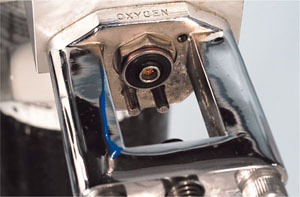
Fig 5-3 Yoke for attachment of gas cylinder.
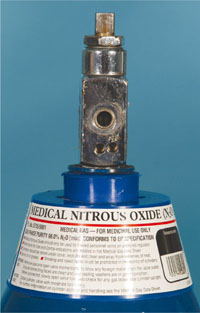
Fig 5-4 Pin Index pattern for nitrous oxide.
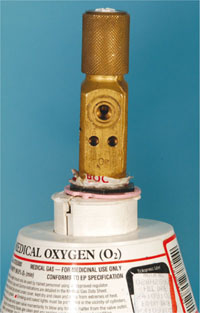
Fig 5-5 Pin Index pattern for oxygen.
The gas-tight fit between each cylinder and the machine is dependent upon the presence of an intact seal between the face of the valve block and the manifold. This is provided by a small (but vital) piece of equipment, the Bodok seal (Fig 5-6). Absence of any one of the four Bodok seals renders the whole machine unserviceable.
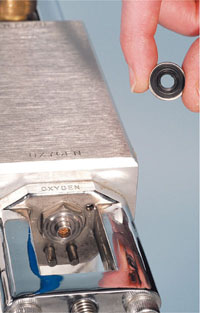
Fig 5-6 Bodok seal.
The nitrous oxide and oxygen pressure gauges give an indication of the liquid and gas remaining in each cylinder. Whilst the oxygen gauge falls continuously in a linear manner as the gas is used, the nitrous oxide gauge will only begin to fall from its maximum reading when all the liquid has been converted to gas. This is because the nitrous oxide cylinder contains both liquid and gas phases and full pressure is maintained until this point.
Pressure-reducing valves located underneath the top plate of the machine reduce the relatively high cylinder pressures to 413 kPa (60 psi) (Fig 5-7). The gases then pass to the head of the machine via colour-coded, non-interchangeable NIST (National Institute of Science and Technology) pipelines.
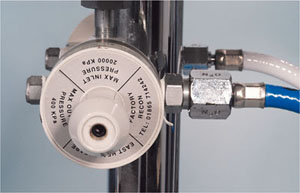
Fig 5-7 Pressure-reducing valve.
Relative Analgesia machine “heads” comprise flow meters for nitrous oxide and oxygen, a control valve for regulating the total gas flow and a mixture dial for adjusting the percentage of oxygen and nitrous oxide (Figs 5-8–5-10). All modern machines are incapable of delivering a gas mixture containing less than 30% oxygen. They are also equipped with a failsafe mechanism which shuts off the nitrous oxide if oxygen ceases to flow. The head has an oxygen flush button and an air entrainment valve which opens if the mixed gas supply fails.
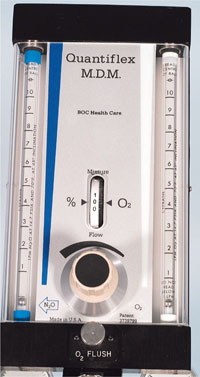
Fig 5-8 Matrx MDM machine head.
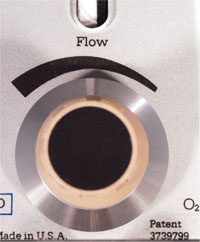
Fig 5-9 Gas flow control.
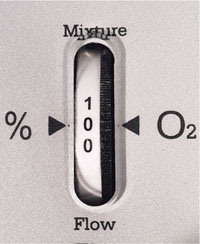
Fig 5-10 Gas mixture dial.
Mixed oxygen and nitrous oxide emerges at the common gas outlet to which the patient breathing system is connected. A 2 litre reservoir bag is also attached at the common gas outlet (Fig 5-11). This is used for adjusting the total gas flow to each individual patient’s minute volume requirement and for monitoring respiration during treatment. Reservoir bags are made of antistatic rubber and are liable to perish, especially in the area of the bag mount (neck).
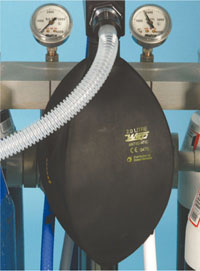
Fig 5-11 Reservoir bag (2 litres).
Although there are many designs, all modern Relative Analgesia breathing systems comprise an inspiratory limb (tube), a/>
Stay updated, free dental videos. Join our Telegram channel

VIDEdental - Online dental courses


